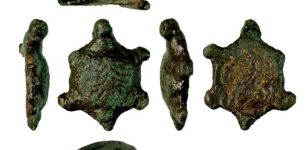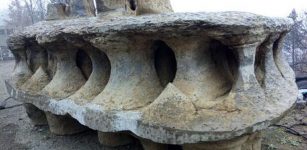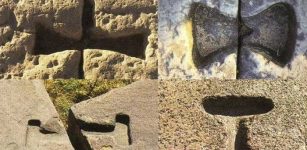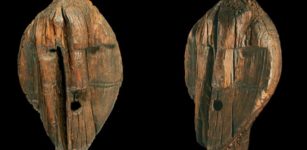Kikimora – Nightly Evil Female Spirit And Goddess Of Chickens In Slavic Beliefs
A. Sutherland - AncientPages.com - Ancient beliefs say that Kikimora spirits (there are many of them) probably live in every household. However, in some versions of her story, she usually appears in homes of dysfunctional, unhappy families where abuse, quarrel, and screams occur daily.
Swamp Kikimora, after which the spider Kikimora palustris is named. Art work by symbolist
painter Vasiliy Ivanovich Denisov (1862–1922).
Kikimora originates in Slavic folklore. In the ancient beliefs of the East Slavs, there are two different kinds of Kikimoras.
One dwells in the forest and is married to the Domovik (Domovoi). The other one comes from the swamp and is married to Leshy.
Kikimora sleeps in dark places of the home, usually in the cellar or behind the furnace, and during the nights, she comes out and works with weaving, spinning, and needlework.
If the home is well kept, Kikimora is happy with the family. She helps them with housework, guards the family members, and protects the chickens. Generally, Kikimora likes skillful and hard-working women that perform their traditional work at home.
An angry and displeased Kikimora may be a troublesome spirit for the family because she interferes in people's lives, disturbs their sleep (mainly irritating children), and makes noises by scratching and whistling at night. She also moves and throws objects, makes them disappear, or changes their places.
Appearance Of Kikimora And Her Psychic Abilities
She is an evil spirit in the form of a small woman with a thimble head, long flowing hair, chicken feet, a body as thin as a straw, and a face, which is almost human-like but shapeless. Kikimora could quickly become invisible.
Illustration of a Kikimora (1934) by Ivan Bilibin (1876-1942). (Kikimora as house-spirit and guardian of chickens - hence her depiction in chicken-like form). Image credit: Ivan Bilibin - Public Domain
Despite her small size, she is a powerful spirit with psychic abilities that help to warn her family of a disaster or dangerous enemies approaching the house where she lives. In other words, she first delivers warnings of misfortune rather than good news.
However, she can be a challenging spirit to work with and keep happy. Once Kikimora is inside the house, it is difficult to get her to leave.
To encounter Kikimora spinning was believed to be a bad omen of impending death.
Kikimora – A 'Chicken Goddess'
In the beliefs of Slavic people, Kikimora is a goddess of chickens. She guards them but sometimes torments them and can even harm pets. Kikimora wants a well-arranged chicken yard where all chickens laying eggs are protected.
The character of Kikimora became a popular inspiration for authors of fairy tales and musicians like Anatoly Lyadov (1855 -1914), a composer and a teacher. He wrote that Kikimora "grows up with a magician in the mountains. From dawn to sunset, the magician's cat entertains Kikimora with beautiful tales of ancient times and distant places as she rocks in a crystal cradle.
She spends her first seven years living in a magician's mountain cave, and after seven years, she leaves the cave to go live among people.
In his poem "Kikimora," Lyadov describes this house spirit as a tiny brown witch with a thimble-sized head and a body no wider than a straw.
Written by – A. Sutherland - AncientPages.com Senior Staff Writer
Updated on March 4, 2023
Copyright © AncientPages.com All rights reserved. This material may not be published, broadcast, rewritten or redistributed in whole or part without the express written permission of AncientPages.com
Expand for referencesMacculloch, J. A.. The Mythology of All Races Vol 3
Leeming, D. The Oxford Companion to World Mythology
Ivanits Linda J. Russian Folk Belief
More From Ancient Pages
-
 Strange Encounter With A Supernatural Being In The 1790s
Featured Stories | Jan 12, 2020
Strange Encounter With A Supernatural Being In The 1790s
Featured Stories | Jan 12, 2020 -
 On This Day In History: Francis Baily First Observed ‘Baily’s Beads’ – On May 15, 1836
News | May 15, 2016
On This Day In History: Francis Baily First Observed ‘Baily’s Beads’ – On May 15, 1836
News | May 15, 2016 -
 Roman Copper-Alloy Tortoise Figurine Discovered In Suffolk, UK
Archaeology | Dec 4, 2023
Roman Copper-Alloy Tortoise Figurine Discovered In Suffolk, UK
Archaeology | Dec 4, 2023 -
 Subterranean Structure In Medieval Naryn-Kala Citadel: Was It The Christian Temple?
Archaeology | Jul 12, 2019
Subterranean Structure In Medieval Naryn-Kala Citadel: Was It The Christian Temple?
Archaeology | Jul 12, 2019 -
 Extremely Rare And Tiny Biblical Coins Discovered Near The Temple Mount
Archaeology | May 30, 2018
Extremely Rare And Tiny Biblical Coins Discovered Near The Temple Mount
Archaeology | May 30, 2018 -
 Reconstructed Face Of A Young Man Who Lived Some 1,300 Years Ago
Archaeology | Jun 11, 2019
Reconstructed Face Of A Young Man Who Lived Some 1,300 Years Ago
Archaeology | Jun 11, 2019 -
 Archaeologists Use Laser Technology To Create Digital Models Of Ancient Artifacts
Archaeology | Jan 28, 2016
Archaeologists Use Laser Technology To Create Digital Models Of Ancient Artifacts
Archaeology | Jan 28, 2016 -
 Ancient City Of Babylon Finally Declared A World Heritage Site By UNESCO
Archaeology | Jul 8, 2019
Ancient City Of Babylon Finally Declared A World Heritage Site By UNESCO
Archaeology | Jul 8, 2019 -
 Curious Giant Shaped Rock In China – An Ancient Man-Made Construction Or Natural Formation?
Featured Stories | Jun 26, 2017
Curious Giant Shaped Rock In China – An Ancient Man-Made Construction Or Natural Formation?
Featured Stories | Jun 26, 2017 -
 Thousands Of Petroglyphs And Inscriptions In Wadi Rum, Jordan – 12,000 Years Of Human Occupation
Civilizations | Oct 23, 2018
Thousands Of Petroglyphs And Inscriptions In Wadi Rum, Jordan – 12,000 Years Of Human Occupation
Civilizations | Oct 23, 2018 -
 Rare Byzantine Gold Coin Discovered In Norway – Was It Brought By Harald Hardrada From Constantinople
Archaeology | Dec 12, 2023
Rare Byzantine Gold Coin Discovered In Norway – Was It Brought By Harald Hardrada From Constantinople
Archaeology | Dec 12, 2023 -
 Dazzling Time Capsule Of Unique Iron Age Artifacts And Celtic Roundhouses Discovered In England
Archaeology | Mar 15, 2022
Dazzling Time Capsule Of Unique Iron Age Artifacts And Celtic Roundhouses Discovered In England
Archaeology | Mar 15, 2022 -
 Was Princess Tadukhipa Of The Mitanni Kingdom Queen Nefertiti?
Civilizations | Mar 15, 2016
Was Princess Tadukhipa Of The Mitanni Kingdom Queen Nefertiti?
Civilizations | Mar 15, 2016 -
 Mycenae Kingdom: Home To King Agamemnon And Tholos Tomb ‘Treasure of Atreus’
Civilizations | Jun 11, 2022
Mycenae Kingdom: Home To King Agamemnon And Tholos Tomb ‘Treasure of Atreus’
Civilizations | Jun 11, 2022 -
 Earliest Evidence Of Humans Using Fire To Shape The Landscape Of Tasmania
Archaeology | Nov 19, 2024
Earliest Evidence Of Humans Using Fire To Shape The Landscape Of Tasmania
Archaeology | Nov 19, 2024 -
 Mystery Of Ancient Metal Clamps – Advanced Lost Technology Modern Science Still Cannot Explain
Ancient Technology | Jul 31, 2020
Mystery Of Ancient Metal Clamps – Advanced Lost Technology Modern Science Still Cannot Explain
Ancient Technology | Jul 31, 2020 -
 Baths Of Caracalla: Italian Antique Thermae Complex For Leisure, Gossip, Business And Socialisation
Featured Stories | Dec 4, 2023
Baths Of Caracalla: Italian Antique Thermae Complex For Leisure, Gossip, Business And Socialisation
Featured Stories | Dec 4, 2023 -
 Metal Artifacts In Southeast Asia Archaeological Theory – Challenged
Archaeology | Jul 31, 2021
Metal Artifacts In Southeast Asia Archaeological Theory – Challenged
Archaeology | Jul 31, 2021 -
 Megaliths In Central France: 30 Prehistoric Monolith Stones And One Human Skeleton – Unearthed
Archaeology | Sep 11, 2019
Megaliths In Central France: 30 Prehistoric Monolith Stones And One Human Skeleton – Unearthed
Archaeology | Sep 11, 2019 -
 Does The Shigir Idol Depict Demons And Evil Spirits?
Archaeology | May 3, 2018
Does The Shigir Idol Depict Demons And Evil Spirits?
Archaeology | May 3, 2018


